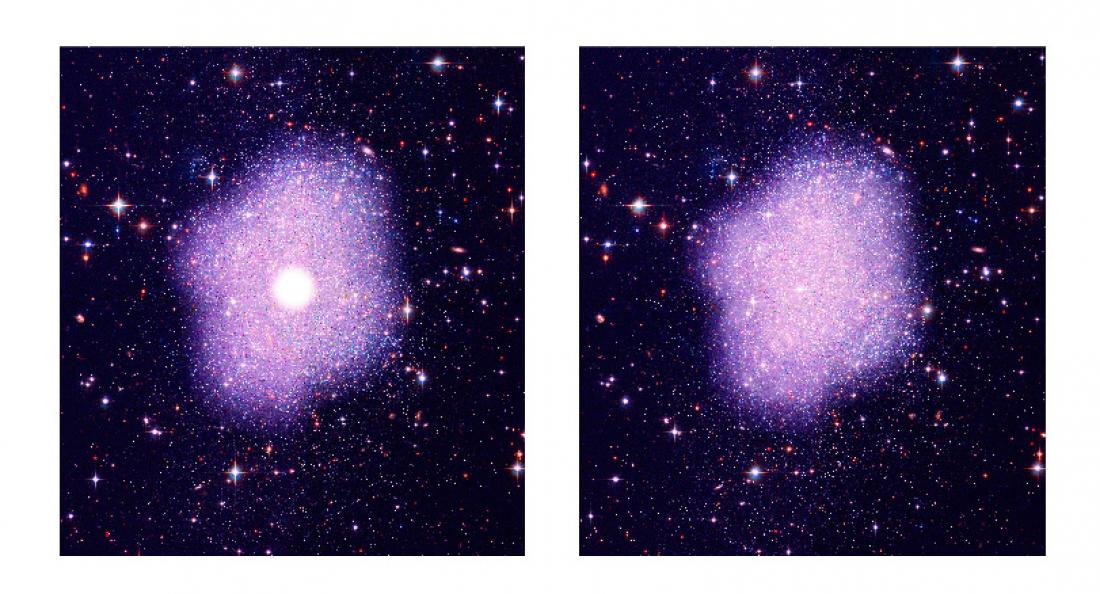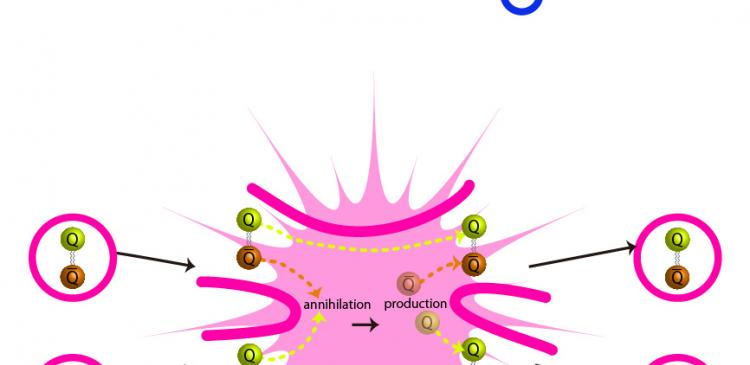Artist's impression of dark matter distribution. Left image assumes conventional dark matter theories, where dark matter would be highly peaked in small area in galaxy center. Right image assumes SIMPs, where dark matter in galaxy would spread out from the center.
A new theory says dark matter acts remarkably similar to subatomic particles known to science since the 1930s.
We owe a lot to dark matter – it is the thing keeping galaxies, stars, our solar system, and our bodies intact. Yet no one has been able to observe it, and it has often been regarded as a totally new exotic form of matter, such as a particle moving in extra dimensions of space or its quantum version, super-symmetry.
Now an international group of researchers has proposed a theory that dark matter is very similar to pions, which are responsible for binding atomic nuclei together. Their findings appear in the latest Physical Review Letters, published on July 10.
“We have seen this kind of particle before. It has the same properties – same type of mass, the same type of interactions, in the same type of theory of strong interactions that gave forth the ordinary pions. It is incredibly exciting that we may finally understand why we came to exist,” says Hitoshi Murayama, Professor of Physics at the University of California, Berkeley, and Director of the Kavli Institute for the Physics and Mathematics of the Universe at the University of Tokyo.
The new theory predicts dark matter is likely to interact with itself within galaxies or clusters of galaxies, possibly modifying the predicted mass distributions. “It can resolve outstanding discrepancies between data and computer simulations,” says Eric Kuflik, a postdoctoral researcher at Cornell University. University of California, Berkeley postdoctoral researcher Yonit Hochberg adds, “The key differences in these properties between this new class of dark matter theories and previous ideas have profound implications on how dark matter can be discovered in upcoming experimental searches.”
The next step will be to put this theory to the test using experiments such as the Large Hadron Collider and the new SuperKEK-B, and a proposed experiment SHiP.
Paper details
Journal: Physical Review Letters, 115, 021301 (2015)
Title: Model for Thermal Relic Dark Matter of Strongly Interacting Massive Particles Authors: Yonit Hochberg (1,2), Eric Kuflik (3), Hitoshi Murayama (1,2,4), Tomer Volansky (5), and Jay G. Wacker (6,7)
Author affiliations:
1 Ernest Orlando Lawrence Berkeley National Laboratory, University of California, Berkeley, California
2 Department of Physics, University of California, Berkeley, California
3 Department of Physics, LEPP, Cornell University, Ithaca, New York
4 Kavli Institute for the Physics and Mathematics of the Universe (WPI), the University of Tokyo
5 Department of Physics, Tel Aviv University, Tel Aviv
6 Quora, Mountain View, California
7 Stanford Institute for Theoretical Physics, Stanford University, Stanford, California
DOI: 10.1103/PhysRevLett.115.021301 (Published July 10, 2015)
Paper Abstract (http://journals.aps.org/prl/abstract/10.1103/PhysRevLett.115.021301) (Physical Review Letters website)
Preprint (http://arxiv.org/abs/1411.3727) (arXiv.org archive website)
CONTACT
Motoko Kakubayashi, Kavli Institute for the Physics and Mathematics of the Universe, The University of Tokyo
E: press_at_ipmu.jp
T: +81-4-7136-5980 (office)
* Please change _at_ to @
RESEARCH CONTACT
Hitoshi Murayama
Director, Kavli Institute for the Physics and Mathematics of the Universe
E: director_at_ipmu.jp
* Please change _at_ to @





